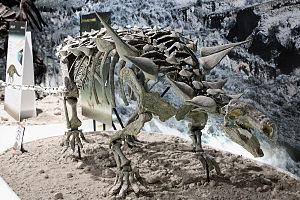Animantarx
| Animantarx | ||||||||||||
|---|---|---|---|---|---|---|---|---|---|---|---|---|

Skeletal reconstruction by Animantarx |
||||||||||||
| Temporal occurrence | ||||||||||||
| Upper Cretaceous (Lower Cenomanian ) | ||||||||||||
| 100.5 to 96.2 million years | ||||||||||||
| Locations | ||||||||||||
| Systematics | ||||||||||||
|
||||||||||||
| Scientific name | ||||||||||||
| Animantarx | ||||||||||||
| Carpenter , Kirkland, Burge & Bird, 1999 | ||||||||||||
| Art | ||||||||||||
|
Animantarx is a genus of pelvic dinosaurs from the Ankylosauria group . She lived in the early Upper Cretaceous North America.
features
Animantarx may have been a relatively small representative of the Ankylosauria with an estimated length of 3 meters, but so far only parts of the skull, the spine and the limbs have been found.
Like all ankylosauria, it is likely to have moved on all fours ( quadruped ), fed on plants and covered by armor made of bone plates, the arrangement of which is unknown. The head was characterized by the strongly domed skull and the small bumps above the eyes.
Discovery and naming
Animantarx fossil remains were found in the Cedar Formation in the US state of Utah and discovered in 1999 by Kenneth Carpenter et al. first described . The name means "living fortress", an allusion to the presumed way of life of the armored ankylosauria. The only species and thus type species is A. ramaljonesi . The finds are dated to an age of around 100 to 96 million years in the early Upper Cretaceous (Lower Cenomanian ).
Systematics
Animantarx is one of the Nodosauridae within the Ankylosauria . Their relationship to other representatives of this group is uncertain due to the sparse finds, M. Vickaryous (2004) lists it under “Nodosauridae incertae sedis ”.
literature
- Matthew K. Vickaryous, Teresa Maryańska , David B. Weishampel : Ankylosauria. In: David B. Weishampel, Peter Dodson , Halszka Osmólska (eds.): The Dinosauria . 2nd edition. University of California Press, Berkeley CA et al. 2004, ISBN 0-520-24209-2 , pp. 363-392.
Individual evidence
- ^ Gregory S. Paul : The Princeton Field Guide To Dinosaurs. Princeton University Press, Princeton NJ et al. 2010, p. 237, ISBN 978-0-691-13720-9 , online .